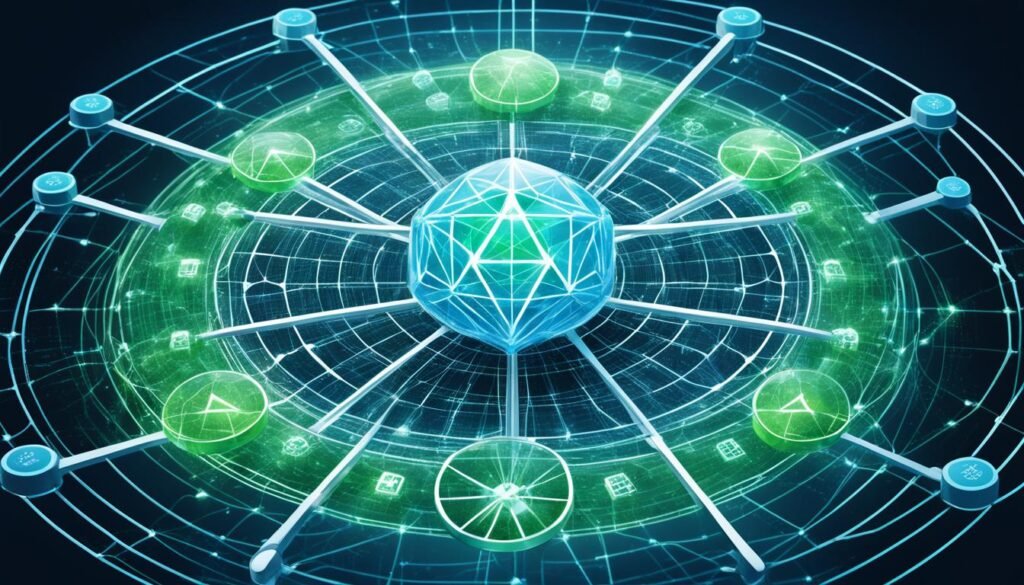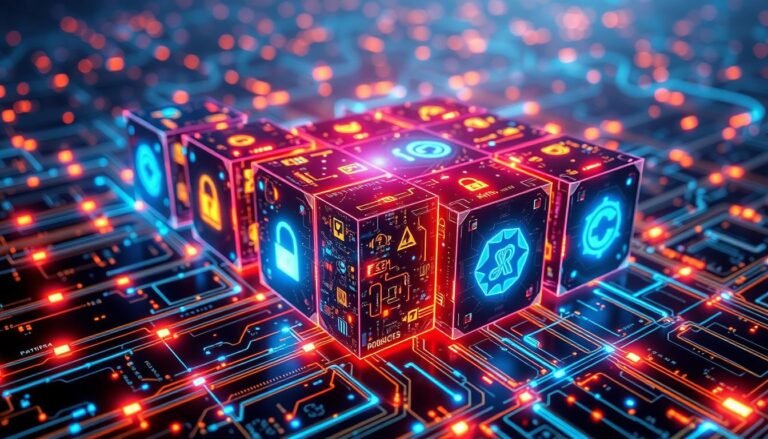Blockchain Technology: Understanding the Decentralized Ledger
Did you know the Bitcoin network checks transactions under 10 minutes per block? This quick verification highlights why blockchain is groundbreaking. It works by sharing copies of a transaction ledger across many networked computers. This makes changing data very tough because of how the network checks and verifies information.
This system is open since it doesn’t need one main authority. It also uses a lot of computer power to check and secure transactions. This effort is needed to keep the ledger safe and trusted.
Blockchain shines in systems like Bitcoin and Ethereum for storing transactions safely. For instance, between April and June 2024, over 32 million ETH was secured on Ethereum by a million users. These large numbers show its strong position in keeping digital currencies safe and running smoothly.
Blockchain brings better safety and clearness wherever it’s used, not just in digital money. It’s credited for saving time by making transactions faster, cutting extra costs, and fighting fraud and cyberattacks. Its impact is felt in many industries and in our daily talks about technology.
Key Takeaways
- Blockchain technology validates Bitcoin transactions in an average of 10 minutes per block.
- The decentralized ledger concept enhances security, making unauthorized data alteration virtually impossible.
- Significant computational power is required for the proof-of-work process, highlighting the high energy consumption of blockchain networks.
- The Ethereum blockchain had over 32 million ETH staked by more than one million validators between April and June 2024.
- Blockchain technology reduces transaction times, cuts costs, and tightens security against tampering, fraud, and cybercrime.
What is Blockchain Technology?
Blockchain technology is a new way to manage data. It focuses on being decentralized, secure, and transparent. This makes data very hard to change without agreement from everyone connected. It’s a key part of digital currencies like Bitcoin and Ethereum. But it’s also used in many other areas.
The Basics of Blockchain
Blockchain is like a public database where data is stored in blocks. These blocks are chained together using secure codes. Once a block is full, it’s added to the chain. This new data is then seen by all users and stays unchangeable. Because it’s decentralized, no single person or group controls it.
Decentralized Ledger Explained
The idea of a decentralized ledger is critical in blockchain. Unlike regular databases, no one controls it. It’s shared by everyone in the network equally. This makes everything more transparent and less prone to fraud. Networks like Bitcoin are open for anyone to join. But some, like private blockchains, limit who can connect to them for more security.
Uses Beyond Cryptocurrency
Blockchain’s impact goes beyond just digital money. It powers smart contracts that run by themselves. These contracts make deals safer without needing a middleman. In supply chains, blockchain tracks every step to ensure products are real and prevent fraud. Health and finance also use blockchain to improve safety and efficiency. Its possibilities are still growing, proving its value in many sectors.
How Blockchain Works
Blockchain technology works by storing data in blocks and linking them in a chain. It keeps data secure and trustworthy. This makes blockchain a reliable way to store information.
Data Storage in Blocks
Every block in a blockchain holds data and points to the block before it. This is secure because of advanced cryptography. The network of users ensures these blocks are valid, keeping the blockchain safe and transparent.
Process of Adding New Blocks
Adding blocks is carefully done with strict rules, using consensus mechanisms. For Bitcoin, the proof-of-work means solving tough puzzles. This ensures new transactions are valid. Ethereum, however, uses proof-of-stake to be fast and secure.
Here is a simple table to show how different cryptocurrencies verify new blocks:
| Cryptocurrency | Consensus Mechanism | Security Feature |
|---|---|---|
| Bitcoin | Proof-of-Work | High computational power needed for verification |
| Ethereum | Proof-of-Stake | Validators based on staked value |
Decentralization in Blockchain
Decentralization in blockchain changes from old centralized systems. It spreads out control to many nodes. This decentralized networks system makes it hard for one player to rule or cheat by using the distributed ledger. In this system, all the nodes keep the same data. This makes a reliable place where any changes that aren’t agreed upon are stopped.
Importance of Decentralization
Decentralization is key, making sure resources are spread well. It helps keep things going even if some parts fail. This can make transactions a bit slower but the system is stronger. Projects by Contura Energy and AWS use this system to do their work more efficiently and save money.
Decentralization vs. Centralization
Choosing between centralization and decentralization in blockchain is a big deal. Central places seem easier to control but can have big problems if they break down or aren’t trustworthy. Decentralized methods give more power to users, keep data safe, and let the network grow. But this way needs more work to keep it running smoothly.
| Aspect | Centralized | Decentralized |
|---|---|---|
| Control | Single point of control | Distributed across nodes |
| Reliability | Prone to single points of failure | Increased stability and service levels |
| Transaction Throughput | Higher throughput | Lower throughput |
| Security | Vulnerable to central attacks | Enhanced security through consensus |
The Role of Consensus Mechanisms
Consensus mechanisms are critical for blockchain networks to work. They decide how transactions and data are checked and put on the ledger. This keeps the blockchain safe and helps people trust it in a decentralized system.

Proof-of-Work
Proof-of-Work (PoW) is an old and popular way blockchains stay secure. It’s mainly used by Bitcoin and Litecoin. Miners in PoW solve tough puzzles to add new transactions to the blockchain.
This system means a new transaction is added to Bitcoin roughly every 10 minutes. Miners win about $16,800 in Bitcoin for adding a new block. But, PoW is slow and costs a lot due to the power it needs for mining.
Though PoW is slow and costly, it’s great at keeping the blockchain safe from hacking. It’s hard for someone to change data without permission under PoW.
Proof-of-Stake
Proof-of-Stake (PoS) is an eco-friendlier way to run a blockchain. It’s used by Ethereum, Cardano, and others. In PoS, those who hold more coins and are willing to risk them can add transactions.
This method is faster and uses less power than PoW. But, it might be less safe and decentralized. In a PoS system, elected people get to add new transactions. The top ones are randomly picked. Finding the best mix of safety, sharing power, and growing is the main goal now.
| Consensus Mechanism | Key Characteristics | Examples |
|---|---|---|
| Proof-of-Work (PoW) |
|
Bitcoin, Litecoin |
| Proof-of-Stake (PoS) |
|
Ethereum, Cardano, Algorand |
Experts are always working on new, better ways to run blockchains. They aim to reward fairly, cut down on harm to the environment, and speed up transactions. New ideas using AI and advanced tech show that blockchain can do more, better confidently.
Applications of Blockchain Technology
Blockchain goes way beyond just digital cash. Its trustworthy, decentralized design is finding use in many fields. Let’s dive into some prime examples of how blockchain is being used.
Cryptocurrency Transactions
Blockchain shines the brightest in handling cryptocurrency trades, like those of Bitcoin and Ethereum. It creates a safe, clear record of every trade. This makes fraud less likely and builds more trust. The way it’s built stops anyone from changing records without permission.
Smart Contracts
Smart contracts mark a big shift thanks to blockchain. These are automated deals that run by themselves. No middleman needed. So, things get done faster and cheaper. They’re key in making finance operations (DeFi contracts) smoother and safer too.
Supply Chain Management
For managing supply chains, blockchain’s a game changer. It tracks every step of a product’s journey. This boosts transparency and fights fraud. It’s especially helpful in areas like fashion, luxury goods, and shipping. There, it makes the whole process more efficient and secure.
Here’s a look at blockchain benefits in different areas:
| Industry | Blockchain Application | Benefits |
|---|---|---|
| Finance | Decentralized Finance (DeFi) Contracts | Increased liquidity, reduced barriers, enhanced capital access |
| Healthcare | Blockchain-based Solutions | Improved patient care, data integrity, drug authenticity |
| Supply Chain | Smart Contracts and Asset Tracking | Enhanced traceability, fraud reduction, product transparency |
| Real Estate | Enterprise Ethereum | Fractional ownership, increased liquidity |
From handling Bitcoin and Ethereum trades to making Smart Contracts, blockchain tech is key. It’s at the core of Decentralized Applications (dApps). These apps offer strong answers to problems in many fields.
Security and Transparency Features
Blockchain technology ensures transactions are trusted thanks to cryptography, decentralization, and agreement among users. It uses cryptographic hashes to secure data. These hashes are crucial. They make changing even one block very hard without changing the entire chain.
Transparency is key. In a decentralized ledger, everyone can see the transactions. This keeps things honest. Because of this, data is both accessible and trusted.
Node verification is a big deal for security. It makes sure everyone in the network agrees about the transactions. This method fights off common threats like phishing or attacks from multiple fake accounts.
While blockchain has dealt with security issues, like the DAO attack, which lost over USD 60 million, it shows the importance of strong protection. Businesses need to focus on security measures to avoid such incidents and maintain trust in this powerful technology.
| Incident | Year | Impact |
|---|---|---|
| DAO Attack | 2016 | Theft of $50M Ethereum |
| Bithumb Hack | 2017 | Data of 30,000 users, $870,000 Bitcoin stolen |
| Bitcoin Gold 51% Attack | 2018 | $18M double-spending |
| Electrum Wallet Phishing | 2020 | $22M stolen in Bitcoin |
It’s also vital to have security plans ready, along with risk management. These efforts make blockchain networks more resilient and keep trust strong in this cutting-edge technology.
Challenges and Limitations
Blockchain technology shows a lot of promise. But, it has some hurdles to overcome for more people to use it well. These hurdles include scalability issues and how much energy it uses.
Scalability Issues
Right now, how big blockchain can get is a big worry. Too many transactions at once might slow everything down and make fees high. Bitcoin and Ethereum, for instance, take more time to process transactions than Visa does. They use hard-to-do and heavy consensus methods like proof-of-work and proof-of-stake.
A way to fix this might be creating systems that help transactions happen outside the main blockchain. These off-chain systems could make transactions quicker and cheaper. But, right now, making blockchain work for lots of people is still tricky.
Energy Consumption
Another big problem with blockchains is how much energy they use. Solving the puzzles in proof-of-work, for example, needs a lot of computer power. This uses up tons of energy and could hurt the environment.
To make things better, some are trying out other ways of making decisions, like proof-of-stake. This could cut down on the energy blockchain uses. Yet, switching to these new methods has its own difficulties. Keeping the network safe and trustworthy is still a big job.
| Challenges | Details |
|---|---|
| Scalability | Limits on transaction throughput, slow processing speeds, and high transaction fees. |
| Energy Consumption | Significant energy required for proof-of-work consensus, raising environmental concerns. |
Growing and changing blockchain is important. Tackling the problems with how big and how much energy blockchain uses is key. This will help make a better, more sustainable system for the future.
Future Potential and Innovations
The future of blockchain looks set for big changes, thanks to new innovations. Especially exciting are decentralized apps (dApps) and improvements in how we vote using blockchain.
Decentralized Applications (dApps)
Decentralized apps (dApps) are a key step forward in blockchain tech. They work peer-to-peer, cutting out the need for central servers. Since 2015, when the Ethereum Frontier Network started, dApps have brought more openness and self-rule.
There are now many apps using smart contracts. These apps let users get involved more and have a say in areas like finance, healthcare, and entertainment.
Blockchain in Voting Systems
Blockchain is also making waves in elections. It offers a new level of security and openness. Information is kept on many computers worldwide, making it very hard to tamper with. This fights fraud and mistakes in how we check who can vote.
These voting systems could really change how elections work. They’re still growing, but we expect to see them in more places soon.
This could also change the future of cryptocurrency, making it safer and more people-powered.
Conclusion
Blockchain technology started in 2008 by Nakamoto has changed how we handle digital transactions. It uses a decentralized, digital ledger for high security, transparency, and efficiency. It doesn’t need banks or governments to approve transactions, which cuts costs and improves trust.
Each block in the chain has an index, timestamp, and digital signatures. These ensure data in each block is safe. A method called proof of work prevents hacking and fraud. There are different types of blockchains – some are open to everyone, others are more private.
Businesses see blockchain as more than just for cryptocurrencies. It’s good for safe, clear records in many industries like finance, managing contracts, and following rules. Although it has some issues, like how much energy it uses, the future looks bright. By 2030, it could add over $3.1 trillion to the economy and change how we do business globally.
FAQ
What is Blockchain Technology?
How does a decentralized ledger work?
What are some uses of blockchain beyond cryptocurrency?
How is data stored in blockchain?
What is the process of adding new blocks to the blockchain?
Why is decentralization important in blockchain?
What is the difference between decentralization and centralization?
What are consensus mechanisms in blockchain?
How do Proof-of-Work and Proof-of-Stake differ?
How is blockchain used in cryptocurrency transactions?
What are smart contracts?
How does blockchain improve supply chain management?
What security features does blockchain offer?
What are the challenges and limitations of blockchain technology?
What are decentralized applications (dApps)?
How can blockchain be used in voting systems?
Source Links
- https://www.investopedia.com/terms/b/blockchain.asp
- https://www.synopsys.com/glossary/what-is-blockchain.html
- https://www.ibm.com/topics/blockchain
- https://www.forbes.com/advisor/investing/cryptocurrency/what-is-blockchain/
- https://online.stanford.edu/how-does-blockchain-work
- https://aws.amazon.com/blockchain/decentralization-in-blockchain/
- https://www.techtarget.com/searchcio/definition/blockchain-decentralization
- https://builtin.com/blockchain/consensus-mechanism
- https://www.investopedia.com/terms/c/consensus-mechanism-cryptocurrency.asp
- https://consensys.io/blockchain-use-cases
- https://builtin.com/blockchain/blockchain-applications
- https://www.ibm.com/topics/blockchain-security
- https://medium.com/@exolo/6-key-security-features-in-public-blockchains-e9022398b7f1
- https://www.forbes.com/sites/bernardmarr/2023/04/14/the-5-biggest-problems-with-blockchain-technology-everyone-must-know-about/
- https://www.techtarget.com/searchcio/tip/5-challenges-with-blockchain-adoption-and-how-to-avoid-them
- https://www.fool.com/investing/stock-market/market-sectors/financials/blockchain-stocks/problems-with-blockchain/
- https://crustlab.com/blog/what-is-the-future-of-blockchain/
- https://medium.com/@edelcoin/blockchain-technology-7f7eae3f373d
- https://www.linkedin.com/pulse/future-trends-blockchain-technology-navigating-horizon-innovation-zbajf
- https://www.oxjournal.org/blockchain-technology-and-its-future-implications/
- https://www.ncbi.nlm.nih.gov/pmc/articles/PMC7004292/
- https://www.enisa.europa.eu/topics/incident-response/glossary/blockchain






